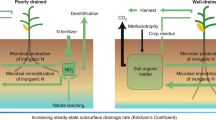Abstract
Farmers in the Broadview Water District in central Californiahave been improving irrigation practices in response to risingirrigation water prices and reductions in water supply since1989, when incentive policies were first implemented to reducethe volume of subsurface drain water generated in theDistrict. The average salinity of water deliveries hasincreased, over time, as the District has recycled largeamounts of drainage water to achieve regional restrictions ondrainage water discharge. We review irrigation and drainageactivities in Broadview since 1986 with an emphasis on thesustainability of crop production when drainage discharge islimited. Average cotton yields in Broadview have declined inrecent years, both nominally and in comparison with averageyields reported for the large county in which Broadview islocated. Average tomato yields in Broadview have increased inrecent years, but county-wide yields have exceeded Broadviewyields with greater frequency than in the late 1980s. Theseobservations suggest that average crop yields in Broadview maybe starting to reflect the increasing salinity of soil andwater resources, which may be due in part to persistentrestrictions on drainage water discharge.
Similar content being viewed by others
References
Ayars J.E., Wichelns D. & Cone D. 1998. Water management principles for drainage reduction and a case study of the Broadview Water District, California. In: Dudley L.M. & Guitjens J.C. (Eds). Agroecosystems and the Environment: Sources, Control, and Remediation of Potentially Toxic, Trace Element Oxyanions. San Francisco, California: Pacific Division of the American Association for the Advancement of Science.
California, State Water Resources Control Board, 1987. Regulation of Agricultural Drainage to the San Joaquin River, SWRCB Order Number W.Q. 85-1, Technical Committee Report, Sacramento, 192 pages.
Carruthers I., Rosegrant M.W. & Seckler D. 1997. Irrigation and food security in the 21st century. Irrigation and Drainage Systems 11: 83–101.
Letey J., Roberts C., Penberth M. & Vasek C. 1986. An agricultural dilemma: Drainage water and toxics disposal in the San Joaquin Valley. Special Publication 3319, Division of Agriculture and Natural Resources, University of California, 56 pages.
Libby L.W. & Boggess W.G. 1990. Agriculture and water quality: Where are we and why? In: J.B. Braden & S.B. Lovejoy (Eds) Agriculture & Water Quality: International Perspectives (pp 9–37). Lynne Rienner Publishers, Boulder.
Loomis J. 1994. Water transfer and major environmental provisions of the Central Valley Improvement Act: A preliminary economic evaluation. Water Resources Research 30(6): 1865–1871.
National Research Council. 1989. Irrigation-Induced Water Quality Problems, National Academy Press, Washington, D.C., 157 pp.
Smedema L.K., Abdel-Dayem S., & Ochs W.J. 2000. Drainage and agricultural development. Irrigation and Drainage Systems 14(3): 223–235.
Wichelns D. & Cone D. 1992a. Tiered pricing motivates Californians to conserve water. Journal of Soil and Water Conservation 47(2): 139–144.
Wichelns D. & Cone D. 1992b. Farm-level and district efforts to improve water management during drought. Irrigation and Drainage Systems 6: 189–199.
Wichelns D. & Cone D. 1996. Economic incentives reduce irrigation deliveries and drain water volume. Irrigation and Drainage Systems 10: 131–141.
Yudelman M. 1998. Water and food in developing countries in the next century. In: J.C. Waterlow, D.G. Armstrong, L. Fowden, & R. Riley (Eds) Feeding a World Population of More Than Eight Billion People (pp 56–68). Oxford University Press, Oxford.
Author information
Authors and Affiliations
Rights and permissions
About this article
Cite this article
Wichelns, D., Cone, D. & Stuhr, G. Evaluating the Impact of Irrigation and Drainage Policies on Agricultural Sustainability. Irrigation and Drainage Systems 16, 1–14 (2002). https://doi.org/10.1023/A:1015537818872
Issue Date:
DOI: https://doi.org/10.1023/A:1015537818872




